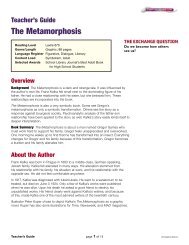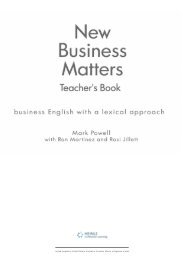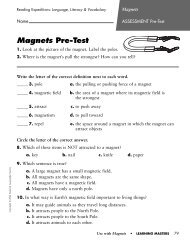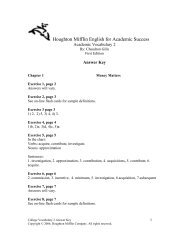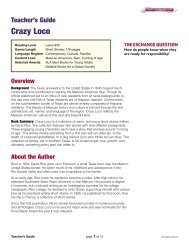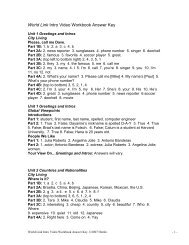Weaving It Together
Weaving It Together
Weaving It Together
Create successful ePaper yourself
Turn your PDF publications into a flip-book with our unique Google optimized e-Paper software.
UNIT 6<br />
CD 1<br />
Track 11<br />
Chapter<br />
11<br />
The readings and follow-up activities<br />
in this unit are about language and<br />
communication. Chapter 11 discusses<br />
secret languages and codes and the roles<br />
they play in people’s lives. Chapter 12<br />
is about the English language and its<br />
infl uence around the world. Here are some<br />
interesting facts about secret languages<br />
and codes:<br />
• President Thomas Jefferson was very<br />
interested in cryptology. He taught a<br />
secret code to Meriwether Lewis, who<br />
headed the Lewis and Clark Expedition<br />
to explore the western frontier of the<br />
U.S. beginning in 1803, in order to<br />
keep information safe from those who<br />
were opposed to Jefferson’s views on<br />
expansion of the new nation.<br />
• The Spartans of ancient Greece used<br />
a code system for transmitting secret<br />
military information in which the sender<br />
wrote a message on a strip of paper or<br />
leather wound around a cylinder. The<br />
strip was then unwound and sent to the<br />
receiver, who decoded it by winding it<br />
around a cylinder of the very same size.<br />
The two cylinders had to be exactly the<br />
same size or the message was garbled.<br />
46 Unit 6<br />
Language<br />
Keeping <strong>It</strong> Secret<br />
Warm-Up<br />
You may start the lesson in one of these ways:<br />
• Ask students to study the writing on<br />
page 145. Invite them to share anything<br />
they know about these alphabets and<br />
languages. Ask: How are languages that<br />
use an alphabet different from your own<br />
codes?<br />
• Have students work in pairs and try their<br />
hand at developing a simple code, using<br />
either letter exchanges or numbers to<br />
represent letters. Each pair can write a<br />
short message (one sentence) to trade with<br />
another pair for decoding, using a key.<br />
• Ask if students are familiar with the<br />
spoken code language pig Latin. Give<br />
brief instructions (found in reading) and<br />
have pairs try to have a conversation<br />
speaking this way.<br />
Pre-Reading Activity<br />
Ask students to brainstorm as many kinds<br />
of code languages and reasons for using<br />
codes as they can. Make a list on the board<br />
and after they have read the selection,<br />
have the class check off each item found in<br />
the reading.<br />
00238-X_006-073.indd 46 11/12/09 8:40 PM



